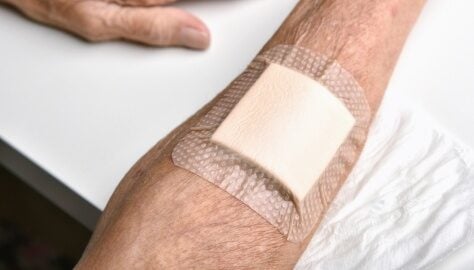Interview with Prof. Thorsten Steinberg, Head of Laboratory, Medical Center – University of Freiburg
A team of researchers led by Prof. Rolf Mülhaupt and Prof. Thorsten Steinberg at the Medical Center – University of Freiburg has developed a thermoresponsive polymer that enables wound dressings to be removed painlessly and without leaving any residue.
This innovation could significantly improve care, particularly in burn treatment and for patients with sensitive skin. In an interview with MEDICA-tradefair.com, Prof. Thorsten Steinberg provides insights into the development process and the advantages of the polymer.
Prof. Steinberg, how did the idea for the development of the thermoresponsive polymer come about?
Prof. Thorsten Steinberg: The idea for the polymer came from a larger research project funded by the Baden-Württemberg Foundation. It began in 2018 and involved a collaboration between the Institute of Macromolecular Chemistry at the University of Freiburg and the Department of Oral Biotechnology at the Freiburg University Medical Center as well as other project partners.
The main aim of the project was to use 3D and 4D printing of programmable and switchable material systems in regenerative medicine. In 4D printing, a material is developed that is not only three-dimensionally malleable, but can also actively change under the influence of an external stimulus, in this case temperature. This gave rise to the idea of creating a polymer that adapts to a wound at body temperature, but can be easily and painlessly removed by cooling.
"There is a great need for wound dressings that can be removed painlessly, especially for patients such as children with large wounds."
Prof. Thorsten Steinberg
Medical Center – University of Freiburg
How exactly does the polymer work?
Steinberg: The polymer is thermoresponsive. At body temperature, the side chains fuse, causing it to adhere firmly to the wound. However, if it is cooled to around zero degrees using a cooling pad for around 30 seconds, the side chains crystallize at the interface between the wound and the wound dressing and the wound dressing can be removed without leaving any residue. This process enables gentle and pain-free wound care.
How was the polymer developed?
Steinberg: The polymer was developed specifically as part of this project. Wound dressings have been around for a long time, but further development in the field of biocompatible thermoresponsive polymers that function according to the “bond/debond on command” mode has been limited until now. During the work, we discovered that polyvinyl acetate (PVA) in combination with a certain amount of fatty acid esters results in a co-polymer that adheres at body temperature and can be dissolved upon cooling.
How is the polymer applied to the wound dressings?
Steinberg: The polymer can be applied to the edges of conventional wound dressings, such as compresses or patches, using the 3D dispensing printing process or by manual application. As soon as it is pressed onto the wound, the polymer reacts to body heat and stably adheres to the skin, similar to conventional plasters.
What is the current development status of the project?
Steinberg: We have developed a functioning prototype and have already tested it on test subjects. A small study showed that the polymer works well. We are now offering it to companies in the wound care sector for further testing. It should be ready for the market by 2026.

The polymer adapts to a wound at body temperature and can be removed easily and painlessly by cooling.
How has the polymer been received by medical professionals?
Steinberg: The feedback has been consistently positive, especially in burns medicine and plastic surgery. There is a great need for wound dressings that can be removed painlessly, especially for patients such as children with large wounds.
Do you also see an application in everyday life, for example for plasters that can be bought in pharmacies?
Steinberg: That is definitely possible. As soon as the polymer is produced on a large scale, it could also be used in conventional dressings. We are already working on scalability and see a good chance that it will also become affordable for the mass market.
Source & Image Credit: Medica






